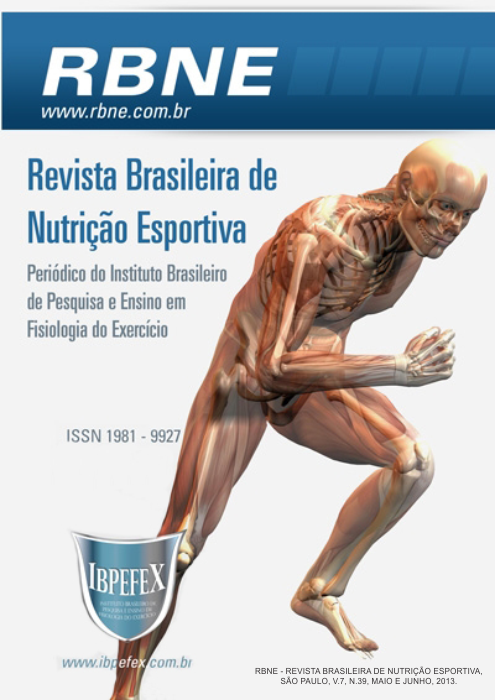Profile of patients seeking care nutrition household (personal diet)
Abstract
In the last two decades, there is a global trend, the so-called nutrition transition, which is characterized by a decrease in the number of people with malnutrition and an increase in obesity levels. In Brazil, data from the Pesquisa de Orçamento Familiar (POF), conducted between the years 2008 and 2009 show that 49.0% of the total population of adults are overweight and 14.8% are considered obese. Thus, the aim of this study is to characterize the profile of patients seeking nutritional home. The study was characterized as exploratory, cross country, descriptive quantitative approach, in which we analyzed 38 case histories of patients who received nutritional care home (personal diet). The majority (84%) of the patients were females andthe average age was 33.53 years. With respect to nutritional status (47%) are in the overweight range or at some level of classification of obesity and (74%) have tried some kind of diet for weight reduction previously. When asked about the emotional state (74%) were considered anxious. Through this study, we see the need to develop strategies in partnership with the patient, so that it is able to understand the importance of adding new habits, in order to find the solution to this problem.
References
-Abrantes, M.M.; Lamounier, J.A.; Colossimo, E. A. Prevalência de sobrepeso e obesidade nas regiões Nordeste e Sudeste do Brasil. Rev. Assoc. Méd. Bras. Vol. 49. Núm. 2. p. 162-166. 2003.
-Apolinario, R.M.C; Moraes, R.B.; Motta, A.R. Mastigação e dietas alimentares para redução de peso. Rev. CEFAC. Vol. 10. Núm. 2. p. 191-199. 2008.
-BernardiI, F.; Cichelero, C.; Vitolo, M.R. Comportamento de Restrição Alimentar e Obesidade. Revista de Nutrição. Vol. 18. Núm. 1. p. 85-93. 2005.
-Brasil. Ministério da Saúde. Secretária de Vigilância em Saúde. Vigitel Brasil 2011: Vigilância de fatores de risco e proteção para doenças crônicas por inquérito telefônico. Brasília-DF. 2012.
-Brasil. Ministério da Saúde. Datasus: Morbidade Hospitalar do SUS-CID 10. Disponível em: <http://tabnet.datasus.gov.br/cgi/tabcgi.exe?sih/cnv/niuf.def>. Acesso em: 15/04/2013.
-Cade, N.V.; Borloti, E.; Vieira, A.R.; Perin, R.; Silveira, K.A.; Ferraz, L.; Bergamini, M.P. Efeitos de um treinamento de autocontrole, aplicado em obesos. Cogitare Enfermagem. Vol. 14. Núm. 1. p. 65-72. 2009.
-Cataneo, C.; Carvalho, A.M. P.; Galindo, E.M.C. Obesidade e aspectos psicológicos: Maturidade emocional, auto-conceito, lócus de controle e ansiedade. Psicologia: Reflexão e Crítica. Vol. 18. Núm. 1. p. 39-46. 2005.
-Carvalho, K.M.B. Obesidade. In: Cuppari, L. Nutrição: Nutrição clínica no adulto. Manole. 2005. p. 149-170.
-Coutinho, M.; Lucatelli, M. Produção Científica em Nutrição e Percepção Pública da Fome e Alimentação no Brasil. Revista de Saúde Pública. São Paulo. Vol. 40. p. 86-92. 2006.
-Duarte, C. A.; Castellani, F. R. Semiologia Nutricional. Rio de Janeiro. Axcel Books. 2002.
-Francischi, R. P. P.; e colaboradores. Obesidade: atualização sobre sua etiologia, morbidade e tratamento. Revista de Nutrição. Vol. 12. Núm. 1. 2000.
-Instituto Brasileiro de Geografia e Estatística. Pesquisa de Orçamentos Familiares 2010. Despesas, Rendimentos e Condições de vida. Disponível em:<http://www.ibge.gov.br/home/estatistica/populacao/condicaodevida/pof/2008_2009/POFpublicacao.pdf> Acesso em: 01/08/2012.
-Koehnlein, E.A.; Salado, G.A.; Yamada, A.N. Adesão à reeducação alimentar para perda de peso: determinantes, resultados e a percepção do paciente. Rev. Bras. Nutr Clin. Núm. 23. p. 56-65. 2008.
-Manassero, J. P.; Morel, R.A.; Dias, R.L.; Pizatto, A.C. Perfil dietético de participantes de um programa de apoio para reeducação alimentar de acordo com o programa “5 ao dia”. Revista da Graduação. Vol. 4. Núm. 2. 2011.
-Oliveira, A.F.; Lorenzatto, S.; Fatel, E.C.S. Perfil de pacientes que procuram atendimento nutricional. Revista Salus. Guarapuava. Vol. 2. Núm.1. p. 13-21. 2008.
-Perez, G.H.; Romano, B.W. Comportamento alimentar e síndrome metabólica: aspectos psicológicos. Rev. Soc. Cardiol. Estado de São Paulo. Vol. 14. Núm. 4. p. 544-550. 2004.
-Pollock, M.L.; Wilmore, J.H. Exercício na Saúde e na Doença. Rio de Janeiro. Medsi. 1993.
-Popkin, B. M.; Larsen, G. The nutrition transition: worldwide obesity dynamics and their determinants. International Journal of Obesity. Núm. 28. p. s2-s9. 2004.
-Sauressig, M.R.; Berleze, K.J. Análise de influências em dietas de emagrecimento. Revista Psico. Vol. 41. Núm. 2. p. 231-238. 2010.
-Tjepkema, M. Adult Obesity. Health Reports, Vol. 17. Núm. 3. p. 9-25. 2006.
-Viana, V. Psicologia, saúde e nutrição: Contributo para o estudo do comportamento alimentar. Análise Psicológica. Vol. 4. p. 611-624. 2002.
-World Health Organization. Obesity: Prevening and managing the global epidemic. Geneva, p. 276, 1998.
-Zacarelli, E.M. Modelo transteórico e curso de vida. In: Fisberg, M.R.; Slater,B.; Marchioni, D.M.L.; Martini, L.A. Inquéritos Alimentares: Métodos e bases científicos. Manole. 2005. p. 53-70.
Authors who publish in this journal agree to the following terms:
- Authors retain the copyright and grant the journal the right of first publication, with work simultaneously licensed under the Creative Commons Attribution License BY-NC which allows the sharing of the work with acknowledgment of the authorship of the work and initial publication in this journal.
- Authors are authorized to enter into additional contracts separately for non-exclusive distribution of the version of the work published in this journal (eg, publishing in institutional repository or book chapter), with acknowledgment of authorship and initial publication in this journal.
- Authors are allowed and encouraged to post and distribute their work online (eg, in institutional repositories or on their personal page) at any point before or during the editorial process, as this can bring about productive change as well as increase impact and impact. citation of published work (See The Effect of Free Access).






